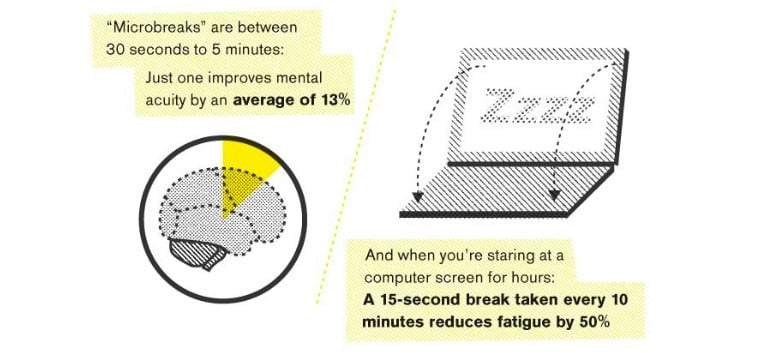The Benefits of Daily Work Breaks

The rat race is real, people.
We are continually hammering ourselves into the ground to be the best, earn the most, and prove our value to others.
Although it’s great to have strong ambition and pride in your work, too much pressure and commitment to the grind can do the exact opposite of what you desire.
Whether feeling the need to be connected to work 24/7, or cramming for a university exam, we often throw sleep and self-care to the wayside in favor of pushing unrealistic expectations upon ourselves.
The result is detrimental—lack of sleep, relaxation, and exercise can affect not only the level of your work (it’s hard to be on your A-game when you’re a worn-out mess), but can also have negative effects on your overall health.
That’s why it’s important to take breaks during your workday.
Culture of Overworking
There is no disputing that technical advancements in today’s modern world have made many of us slaves to every ping and ring of our digital devices.
According to a report by bankmycell.com, the average smartphone user in the U.S. checks their device 47 times a day—this is on top of us being tethered to our laptops. Most of us can’t even go a few feet without our smartphone in our pocket or our Apple Watch buzzing on our wrist.
Aside from the obvious issues that this kind of behavior breeds (anxiety, sleep deprivation, and even depression or loneliness), it also makes us feel like we need to be quick to respond to everything that comes our way.
Since most people are checking their smartphone nearly 50 times a day, we feel that it’s likely that our bosses, clients, and customers expect us to have lightning reflexes when an issue arises or a request is made.
This—coupled with the assumption that our peers and competitors are working around the clock—is prohibiting us from taking the breaks necessary to refresh our mind and recharge our energy.
Full-Time v. Freelance
To an outsider, it may seem like freelancers are the lucky ones who can avoid feeling tied down to work at all moments of the day—after all, they make their own hours, right?
Wrong.
Though it’s true that many freelancers have the freedom to work remotely or be selective about the projects they accept, there are many factors (including those exact “perks”) that can make freelancers feel like they can’t take precious breaks during the day.
Full-time employees are required to show up to the office during specific times each working day, which in itself can be a gauge of that employee’s commitment and work ethic. If you are habitually on time and present during meetings, that certainly speaks volumes to your boss.
However, as a freelancer, there can be a constant need to prove your dedication by being available and responsive all day and night long—not just within regular office hours.
Similarly, a full-time employee is usually paid an annual salary that compensates for around 40 hours of work each week. (Of course, there are many full-time employees across many different industries who work more than 40 hours a week or also feel the pressure to be available at all hours of the day.)
But, for a freelancer, you are likely either being paid hourly (so it makes sense that you would want to cram as much work in as possible) or on a retainer, which manifests a worry that you need to constantly prove your worth to clients.
On top of that, a freelancer usually juggles multiple clients, so this means more demands, emails, and calls from more people.
Because of this, it can feel difficult to take short breaks throughout the day—let alone a solid lunch break—or shut it all down at the end of the typical workday.
Health Consequences

As we mentioned in the beginning, failing to take breaks during the day can have a negative impact on your health—both physical and mental.
Failing to take breaks during the day can have a negative impact on your health—both physical and mental. Share on XFor starters, workers (freelance or full-time) who sit at a desk on a computer all day can experience a laundry list of medical issues.
As experts at the Mayo Clinic put it, “Research has linked sitting for long periods of time with a number of health concerns. They include obesity and a cluster of conditions—increased blood pressure, high blood sugar, excess body fat around the waist and abnormal cholesterol levels—that make up metabolic syndrome…Any extended sitting—such as at a desk, behind a wheel or in front of a screen—can be harmful. An analysis of 13 studies of sitting time and activity levels found that those who sat for more than eight hours a day with no physical activity had a risk of dying similar to the risks of dying posed by obesity and smoking.”
Yikes!
And, even if you’ve invested in a standup desk, there are still mental repercussions to not taking breaks. In fact, it can actually reduce productivity since you’re not giving your brain a chance to rest and reset.
You’re also more likely to experience burnout which can affect your other responsibilities and relationships, or make it so you end up resenting and disliking your job.
Taking Breaks
Okay, so now that you’re (hopefully) convinced that it’s important to take breaks throughout the workday, let’s discuss when and how.
There are different schools of thought when it comes to how often you should be taking a pause from work.
Some suggest taking a 15-minute break every 75 to 90 minutes, since that is the typical timeframe of a college course and how much our brains can absorb in one sitting.
However, according to the Pomodoro Technique, it’s optimal to take quick microbreaks every 25 minutes. Though it may seem like the breaks here are too frequent (you don’t want to interrupt your train of thought or a good grove), it could just be better suited for when you’re trying to tackle a specific task.
What Technique Should You Use?

Source: www.lifehack.org
The truth is, the right method will depend on your type of work and individual worth ethic. We all have different times of day when we’re the sharpest or can dial into a larger project—just make sure you are working toward systemizing your own pattern so you can be sure to take ample breaks while you work.
If you aren’t sure how to determine your personal preferences, it may be beneficial to begin tracking your time.
By using an automatic tracking tool like Timing, you’re able to get a complete sense of how (and where) you spend your time during the day without the added burden of having to write down your activities or watch the clock.
You may find that your most productive hours are in the morning after you’ve had your coffee and before your stomach starts growling for a snack. Alternatively, you may notice that your fingers tend to scroll Facebook or news sites during an afternoon lull.
Use all of this information to your advantage—maybe you need 15-minute pauses every 90 minutes throughout the day, with an allotted 30 minutes for random web surfing at 3pm to charge you for the remainder of the afternoon.
Whatever the case, you can also use Timing to schedule break reminders and look back at the week to ensure you are sticking to your break plan.
The Bottom Line
It should be clear now that taking small breaks throughout the day to stretch your legs and clear your mind will, in the end, make you a better, more productive worker.
We know it can be difficult to surrender to this healthy habit when we live in a working society that feels like an endless hamster wheel, but we can promise you that by setting your own boundaries (and putting away the electronics once in a while!) you will be a happier, healthier, and more successful person.
